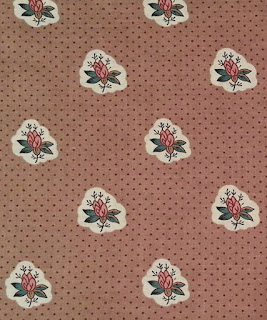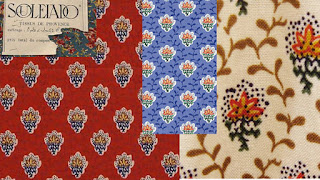Becky Brown's repro block with
a Provincial print in primary colors.
Wendy's foulard block.
The yellow floret in grid format
could also be called a Provincial print.
Evelyne's chrome yellow reproduction.
About 1800 European printers began developing
sophisticated techniques to combine primary colors.
Early 19th-century quilt with multi-colored roller prints.
Red, blue, yellow and green---all applied with recent technology.
Mills got quite proficient at combining colors in roller-printed cottons.
Vintage print
Customers must have been thrilled with so much color
so well-registered and so color fast.
Swatches in Provincial-style, primary colors
from the Stoffdruckmuseum in Mulhouse
Foulards set grid fashion were a favorite set.
As were stripes.
These imported prints appear in
American quilts from about 1820 to 1870.
Americans were partial to the multi-color prints with red grounds. Quilts pieced of red Provincial prints became a fad about 1840 that lasted for decades.
Reproduction star from Bettina Havig
Catherine Fried's block (about 1850) features a Provincial style
print in green, yellow and brown on a Turkey red ground.
The brown spots are rotting due to the iron mordant,
leaving holes showing the quilt's white
cotton batting.
The popular red prints fit into several categories, classified by dye, technology, set and style. Catherine's red cotton might be classified as any one of the following:
- Turkey red prints (dye)
- Early roller or cylinder prints (technology)
- Foulard or grid sets (set style)
- Provincial-style (overall color and design style)
- Indienne-style (figure and set style)
- Mignonettes or small, simple florets (figure style)
Small florals were also printed with fancy machine grounds.
requiring a halo of color between the figure and the fancy ground.
Vintage early quilt
Various technical detail dictated the halo,
Current Souleiado print
a characteristic that has become part of the French Provincial style
although it's no longer necessary.
Reproductions
Elizabeth D's repro block.
Primary colors, a definite grid set.
Savonnerie is one of Sandy Klop's many Provincial reproduction
collections for Moda.
She included a stripe.
Repro from William Penn's Vision---halo and all.
The print Barbara S has used to alternate with her stars.
Ann's version of Di Ford's pattern
Mount Mellick really captures the multi-color, primary palette
Gladi's been setting her stars.
She is sticking with a primary palette
that echoes the multicolored prints.
What to Do With Your Stack of Stars?
Alternate with a Pincushion Block.
32 stars
32 alternate blocks
48" square
We've gone way back in time so we might want a set inspired by
early patchwork.
We could alternate this block with the stars.
The Orange Peel, Pincushion or Melon block is
one of the early-19th-century block designs.
Early 19th-century quilt
Collection of the Helen F. Spencer Museum of Art
at the University of Kansas
I made a small interpretation of that quilt
for an AQSG Study several years ago.
The fabric was the Spencer Museum
collection that Terry Thompson and I did for Moda.
I appliqued my Orange Peels; placed the
centers on the background.
Blocks on point in this early quilt featuring a dark ground
floral trail print and a stripe. These are probably pieced.
Vintage quilt, about 1840-1880
From the Quilt Index
I thought the star/pincushion combination above would be more dramatic with just
one star in the alternate blocks.
Piece or applique the pattern below.
How to print the pattern:
Create a word file or a new empty JPG file that is 8-1/2" x 11".
Click on the image above.
Right click on it and save it to your file.
Print that file out 8-1/2" x 11". The straight side of piece B should measure 6" on the dark sewing line.







































7 comments:
Oh boy! I can finally justify cutting into some of my Souleiado prints purchased in St. Barts in 1993. Yes, it takes me a long time to cut into fabrics I adore. Gladi's quilt is sensational!
I made my Dear Jane in red and green fabrics from the Provence. I visit that part of France several times a year. Apart from Souleiado, you also have fabrics from Valdrome and les Olivades.
Thanks again for all the inspiration! I love these prints :0)
Ooh la la! Love these prints.
I had no idea that my Souleiado prints were repro 19th Century! What a treat--now I know where to keep them (and how to use them!)
I do love the prints! These are wonderful. Thanks for inspiring!
I got quite a kick out of seeing my star used as an example in the reproduction section! Thank you for all you do Barbara. I have been learning so much. I have many, many stars to catch up on and plan to keep on with them right into the new year. My love of fabric grows and grows! Elizabeth D
Post a Comment